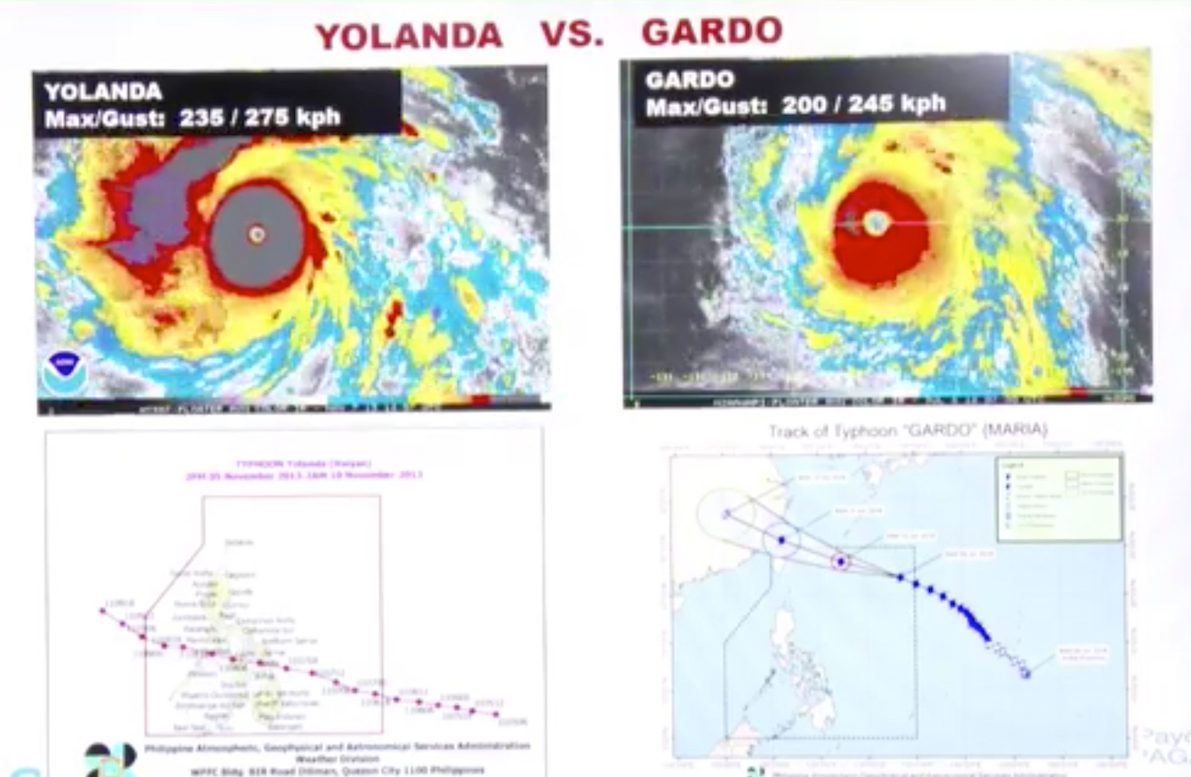SUMMARY
This is AI generated summarization, which may have errors. For context, always refer to the full article.

MANILA, Philippines – State weather bureau PAGASA clarified on Monday, July 9, that Typhoon Gardo (Maria) is different from Super Typhoon Yolanda (Haiyan), which devastated Central Visayas in November 2013.
Here’s how they differ, according to PAGASA Weather Division chief Esperanza Cayanan:
1. Classification
- Gardo is a typhoon, with maximum winds of 200 kilometers per hour (km/h) near the center as of Monday morning.
- Yolanda was a super typhoon, with maximum winds that reached 235 km/h.
“Kung titingnan ‘nyo po ‘yung sirkulasyon ni Yolanda compared kay Gardo, mas malaking area at mas malakas ‘yung dala niyang hangin at ulan.”
(If you look at the circulation of Yolanda compared to Gardo, it covered a much wider area and it brought stronger winds and heavier rainfall.)
2. Track
- Gardo will not make landfall at all. It will just stay in the upper portion of the Philippine Area of Responsibility (PAR), near the boundary.
- Yolanda made landfall, directly hitting provinces in the Visayas.
“‘Yung track ni Yolanda mababa, talagang sapul ‘yung ating bansa…. Itong si Gardo eh doon lang po sa corner ng Philippine Area of Responsibility, so malayo po siya sa atin. Wala po tayong direktang epekto mula sa hagupit ng hangin nitong si Gardo, so we are just preparing for the rainfall [from the enhanced southwest monsoon].”
(Yolanda’s track was lower, it really hit our country…. But Gardo will just stay in the corner of the Philippine Area of Responsibility, so it’s far from land. We won’t directly feel the effects of Gardo’s winds, so we are just preparing for the rainfall [from the enhanced southwest monsoon].)
PAGASA also explained why the United States’ Joint Typhoon Warning Center (JTWC) classifies Gardo as a super typhoon.
“Iba po ‘yung pamantayan at panuntunan nila sa pag-i-issue po ng winds, so mas malakas po talaga ‘yung ibinibigay nilang hangin. Kaya kung ico-compare ‘nyo, ‘Eh bakit do’n sa US ang lakas ng bagyo, bakit dito sa Pilipinas eh mahina lang?’ Dahil po ang kanilang ginagamit ay one-minute average nung winds, samantalang dito po sa PAGASA at kasama po ‘yung mga typhoon committee members dito sa Asia – ang ginagamit po namin officially ay 10-minute average nung hangin, kaya talaga pong merong discrepancy,” Cayanan said.
(The JTWC has different guidelines for classifying winds, so theirs will really be stronger. You’re comparing, “Why is the typhoon stronger in the US, and weaker here in the Philippines?” It’s because the JTWC uses the one-minute average for wind classification, unlike here in PAGASA and for other typhoon committee members in Asia – what we use officially is the 10-minute average, that’s why there will really be a discrepancy.)
PAGASA Deputy Administrator for Administrative and Engineering Services Catalino Davis reiterated that Gardo is only a typhoon based on their standards. A super typhoon, for PAGASA, has maximum winds exceeding 220 km/h. (READ: FAST FACTS: Tropical cyclones, rainfall advisories)
“Of course, hindi naman siya (Gardo) lampas sa 220 [km/h], hindi talaga natin siya puwedeng mapilit na siya ay super typhoon. Official nating classification eh,” Davis said.
(Of course, Gardo’s maximum winds have not exceeded 220 [km/h], so we can’t insist it’s a super typhoon. We’re following our official classification.)
PAGASA also emphasized that it is the Philippines’ official weather authority.
“Ang PAGASA po ang officially mandated when it comes to providing advisories, warnings, at forecasts sa Philippine Area of Responsibility. Member po tayo ng World Meteorological Organization, kaya ito po ‘yung mandato namin at ‘yun pong ibinibigay ng PAGASA, ‘yun po ‘yung official,” Cayanan said.
(PAGASA is the one officially mandated when it comes to providing advisories, warnings, and forecasts for the Philippine Area of Responsibility. We’re a member of the World Meteorological Organization, that’s why this is our mandate and the data that we give are considered the official data.)
– Rappler.com
Add a comment
How does this make you feel?
There are no comments yet. Add your comment to start the conversation.